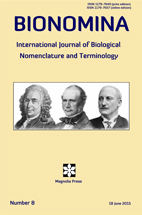Abstract
The absence in the Code of Rules for the nomenclature of zoological taxa above the rank superfamily is an impediment to universal and unambiguous communication about the higher taxonomy of animals. Pending the possible fixing of the Code in this respect, it appears justified to develop a set of simple ‘guidelines’ which could be adopted consensually by the taxonomists who wish so. They could include: (1) the convention that the ‘same name’ given to different higher taxa results in the existence (and therefore availability) of different homonymous nomina, having different authors and dates; (2) the convention that a nomen of higher taxon first introduced clearly as a scientific, not vernacular, name but in a non-Latin form, and that was latinised subsequently in the literature, should be credited to the author of the original work; (3) the need to ‘protect’ the best known and most often used higher zoological nomina (sozonyms and sozodiaphonyms), with the dominant meanings and spellings that they have had for decades or centuries in the biological literature, irrespective of being or not the first ones to have been proposed for the taxa at stake or among homonyms; (4) the implementation of the Principles of Homonymy and of Priority among all the other nomina of higher taxa. These proposals are illustrated by examples in amphibian higher nomenclature, concerning the well-known nomina Amphibia and Batrachia, which have been the matter of recent controversies. An unexpected finding is reported here: that a similar debate on this same question developed in the years 1889–1910, mostly in the journal Science, and was closed by a clear and simple solution, which has fallen into complete oblivion since then. This suggests that our databases are incomplete and that we should be more humble in our debates than we often are, as we are still missing important pieces of information on the past literature.

